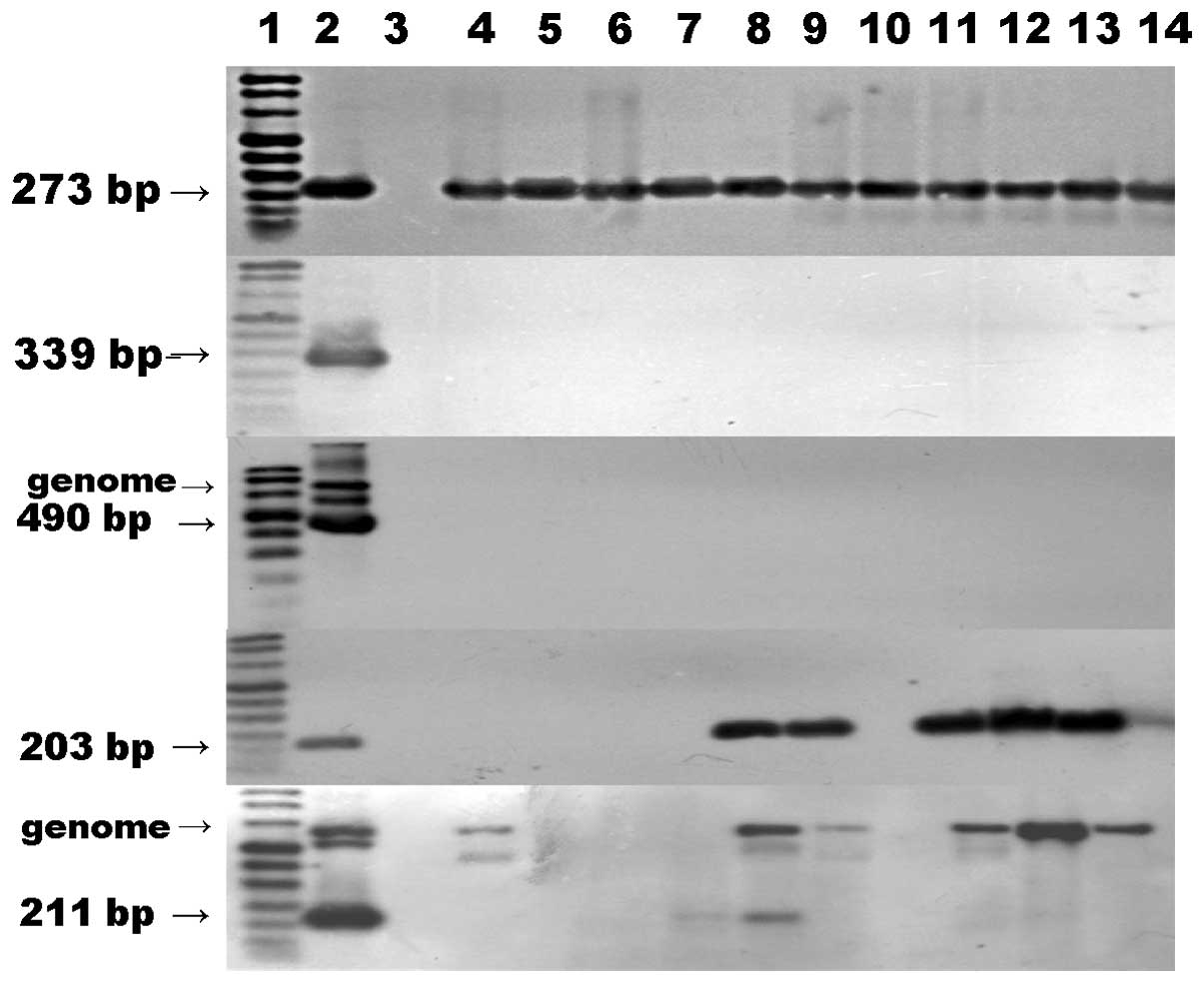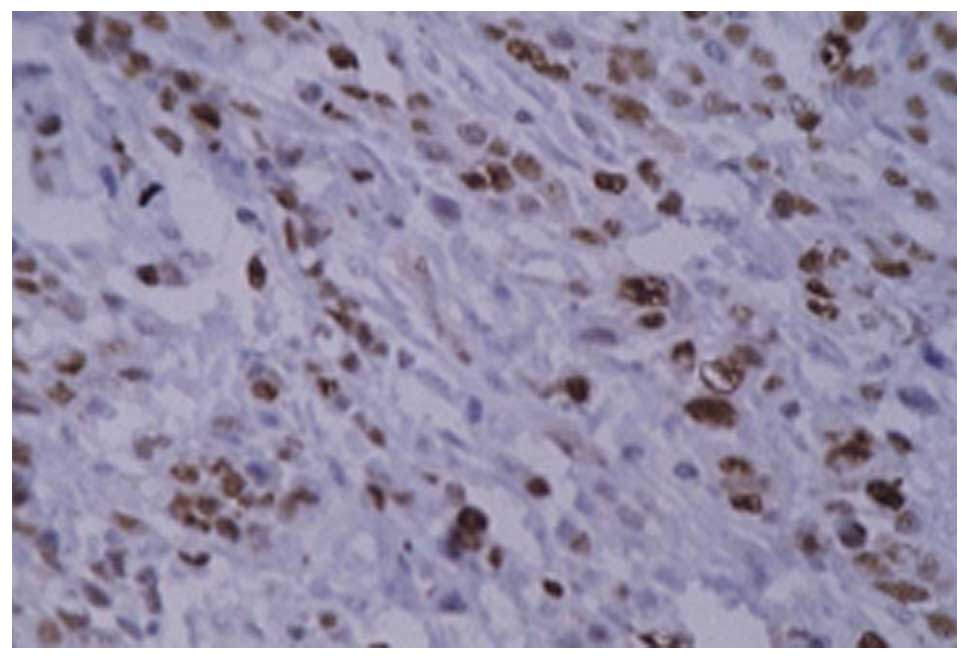Expression of c-myc and PCNA in Epstein‑Barr virus-associated gastric carcinoma
- Authors:
- Shiguang Zhu
- Ping Sun
- Yingxin Zhang
- Liping Yan
- Bing Luo
-
View Affiliations
Affiliations: Department of Oncology, Yantai Yuhuangding Hospital, Yantai, Shandong 264000, P.R. China, Central Laboratory, The People's Hospital of Liaocheng City, Liaocheng 252000, P.R. China, Clinical Laboratory, Qingdao Central Hospital, Qingdao 266042, P.R. China, Department of Microbiology, Medical College of Qingdao University, Qingdao 266021, P.R. China
- Published online on: February 22, 2013 https://doi.org/10.3892/etm.2013.972
-
Pages:
1030-1034
Metrics:
Total
Views: 0 (Spandidos Publications: | PMC Statistics:
)
Metrics:
Total PDF Downloads: 0 (Spandidos Publications: | PMC Statistics:
)
This article is mentioned in:
Abstract
The aim of this study was to detect the expression of proliferatng cell nuclear antigen (PCNA) and c-myc in Epstein‑Barr virus (EBV)-associated gastric carcinoma (EBVaGC) and EBV-negative gastric carcinoma (EBVnGC), as well as the expression of EBV-encoded proteins in EBVaGC and their effect on carcinogenesis and the development of gastric cancer. The PCNA and c-myc protein levels were assessed by immunohistochemistry in 13 EBVaGC and 45 EBVnGC specimens. The expression of related genes of EBV, including EB nuclear antigen (NA)-1 and EBNA2 genes, latent membrane protein 1 (LMP1) and early genes BARF1 and BHRF1 were tested by reverse transcription-polymerase chain reaction (RT-PCR) and southern blotting. The PCNA labeling index (LI) of EBVaGCs, EBVnGCs and the corresponding adjacent tissues of EBVaGCs were 49.3768±12.1832, 14.839±7.1847, 35.613±8.3831 and 24.2735±10.1332, respectively. The PCNA LI was significantly different between EBVaGC and EBVnGC of EBVaGC (t=4.686, P<0.01). The difference between EBVaGC and corresponding adjacent tissues of EBVaGC was also significant (t=8.805, P<0.01). The expression of c-myc protein was detected in 33 of 58 (55.39%) gastric carcinomas and in 21 of 58 (36.21%) adjacent tissues. There was a significant difference between the two groups (χ2=4.989, P<0.05). The expression of the c-myc protein was detected in 8 of 13 (61.54%) EBVaGCs and in 25 of 45 (55.56%) EBVnGCs. The difference between the two groups was not significant (χ2=0.147, P>0.05). EBNA1 mRNA was detected in all 13 EBVaGC cases, while EBNA2 and LMP1 mRNA was not detected in these cases. Of the 13 EBV-positive samples, 6 exhibited BARF1 transcripts and 2 exhibited BHRF1 transcripts. c-myc expression did not correlate with the presence of EBV in EBVaGC. EBV infection may induce PCNA expression. The lack of EBNA2 and LMP1 protein expression in EBVaGC suggests that EBNA2 and LMP1 do not correlate with cell apoptosis and c-myc expression. Early genes BARF1 and BHRF1 may play an important role in the development and progression of gastric carcinomas by immortalizing epithelial cells.
View References
|
1
|
Shah KM and Young LS: Epstein-Barr virus
and carcinogenesis: beyond Burkitt’s lymphoma. Clin Microbiol
Infect. 15:982–988. 2009.
|
|
2
|
Wu MS, Shun CT, Wu CC, Hsu TY, Lin MT,
Chang MC, Wang HP and Lin JT: Epstein-Barr virus-associated gastric
carcinomas: relation to H. pylori infection and genetic
alterations. Gastroenterology. 118:1031–1038. 2000. View Article : Google Scholar : PubMed/NCBI
|
|
3
|
Akiba S, Koriyama C, Herrera-Goepfert R
and Eizuru Y: Epstein-Barr virus associated gastric carcinoma:
epidemiological and clinicopathological features. Cancer Sci.
99:195–201. 2008. View Article : Google Scholar : PubMed/NCBI
|
|
4
|
Sugiura M, Imai S, Tokunaga M, et al:
Transcriptional analysis of Epstein-Barr virus gene expression in
EBV-positive gastric carcinoma: unique viral latency in the tumor
cells. Br J Cancer. 74:625–631. 1996. View Article : Google Scholar : PubMed/NCBI
|
|
5
|
zur Hausen A, Brink AA, Craanen ME, et al:
Unique transcription pattern of Epstein-Barr virus (EBV) in
EBV-carrying gastric carcinomas: expression of the transforming
BARF1 gene. Cancer Res. 60:2745–2748. 2000.PubMed/NCBI
|
|
6
|
Oudejans JJ, van den Brule AJ, Jiwa NM, et
al: BHRF1, the Epstein-Barr virus (EBV) homologue of the bcl-2
protooncogene, is transcribed in EBV associated B-cell lymphomas
and in reactive lymphocytes. Blood. 86:1893–1902. 1995.PubMed/NCBI
|
|
7
|
Ishii H, Gobe G, Kawakubo Y, et al:
Interrelationship between Epstein-Barr virus infection in gastric
carcinomas and the expression of apoptosis-associated proteins.
Histopathology. 38:111–119. 2001. View Article : Google Scholar : PubMed/NCBI
|
|
8
|
Yang J, Deng X, Deng L, et al:
Epstein-Barr virus LMP1 activates human telomerase transcription
via c-myc expression. Chinese Journal of Virology. 19:240–244.
2003.
|
|
9
|
Li Z and Zong Y: Effects of LMP-1
expression on neoplastic cell proliferation and apoptosis in
nasopharyngeal carcinoma. Zhonghua Bing Li Xue Za Zhi. 28:340–343.
1999.(In Chinese).
|
|
10
|
Sheng W, Decaussin G, Sumner S, et al:
N-terminal domain of BARF1 gene encoded by Epstein-Barr virus is
essential for malignant transformation of rodent fibroblasts and
activation of BCL-2. Oncogene. 20:1176–1185. 2001. View Article : Google Scholar : PubMed/NCBI
|
|
11
|
Sheng W, Decaussin G, Ligout A, et al:
Malignant transformation of Epstein-Barr virus-negative Akata cells
by introduction of the BARF1 gene carried by Epstein-Barr virus. J
Virol. 77:3859–3865. 2003. View Article : Google Scholar : PubMed/NCBI
|
|
12
|
Huang H, Pan X and Yu L: The effect of
Epstein-Barr virus gene BHRF1 expression on the apoptotic
resistance of nasopharyngeal carcinoma cells. Zhonghua Zhong Liu Za
Zhi. 20:245–247. 1998.(In Chinese).
|















